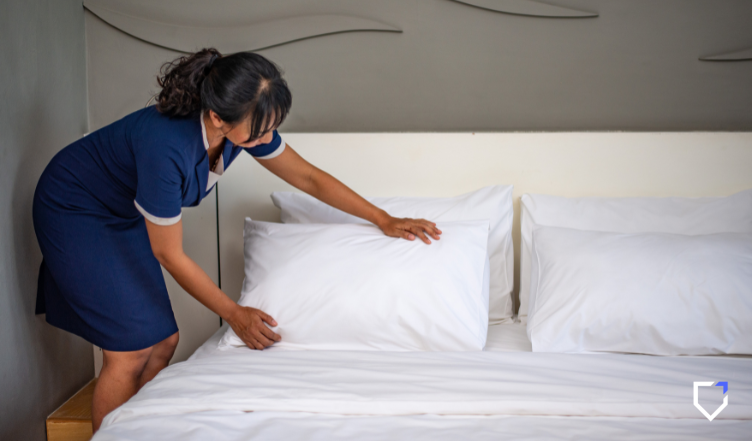For employers in the hotel industry, meeting OSHA requirements like the Cal/OSHA standard requires ongoing attention and work. To ensure continuous compliance and accurate, on-time reporting, employers need to:
- develop controls to prevent or minimize exposures to work conditions that cause repetitive motion injuries,
- conduct worksite evaluations,
- implement worker training programs that address the causes and controls of repetitive motion injuries
A wearable technology program can assist hotel housekeeper employers in meeting OSHA requirements in multiple ways. Data insights help identify potential risks to a workforce and support timely corrective measures. Furthermore, a wearable program can provide continuous coaching on proper posture for common high-risk movements among housekeepers, such as improper lifting while making a bed, or awkward bending and twisting while cleaning a bathroom.
Identify Potential Risks
In worksite hazard evaluations, employers are required to identify unsafe conditions and work practices with respect to potential causes of musculoskeletal injuries to housekeepers.
A wearable platform helps employers recognize high-risk movements among workers that lead to musculoskeletal injuries, such as repetitive motion injuries. Data from wearable devices uncover who is performing excessive high-risk postures, what those movements are, and when, where and how often they are occurring. It can also reveal the potential causes that are putting employees at risk.
Take Corrective Measures
As part of a written Musculoskeletal Injury Prevention Program, employers must include methods or procedures for correcting identified hazards in a timely manner.
Wearables can automatically recognize risky postures and alert users. These real-time alerts help employees correct unsafe movements and create new habits that drive sustained behavior change. Over time, workers reduce their high-risk postures, which directly leads to fewer injuries. An effective wearable platform makes it easy for employers to track and show reduced high-risk postures across an entire workforce.
Data can also be sorted by job type, day of the week, type of high-risk posture, and more, allowing employers to improve workplace ergonomics through targeted training and coaching, as well as through workstation and work process redesigns.
Provide Continuous Coaching
The Cal/OSHA standard requires employers to provide training elements covering body mechanics and safe practices, including the identification of workplace hazards.
The real-time alerts provided by a wearable program can serve as a continuous coaching system for workers. They remind employees when a posture is performed that puts them at risk of injury, teaching them to identify potential risks and to use proper body mechanics. This continuous coaching method is significantly more effective than one-time training efforts.
Proactive Risk Prevention is the Future
For reducing the risk of musculoskeletal injuries among housekeeping employees, and among myriad other labor-intensive essential roles, the shift to a preventative approach to risk is the way of the future. Kinetic Insurance is pioneering this approach with its tech-driven, proactive workers’ compensation offering.
Our workers’ comp policies include free wearable tech that can help employers comply with multiple components of the Cal/OSHA standard while reducing workplace injuries and lowering premium costs.
